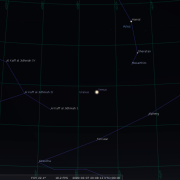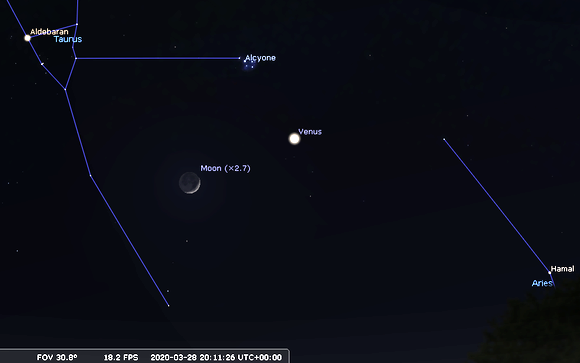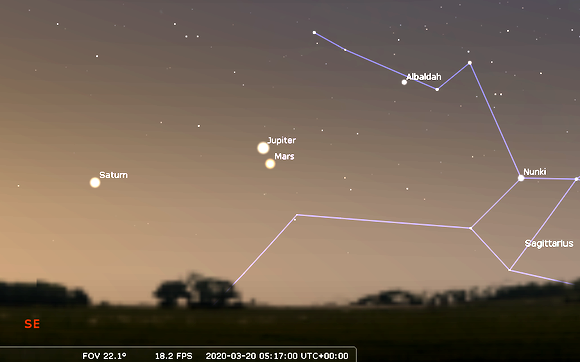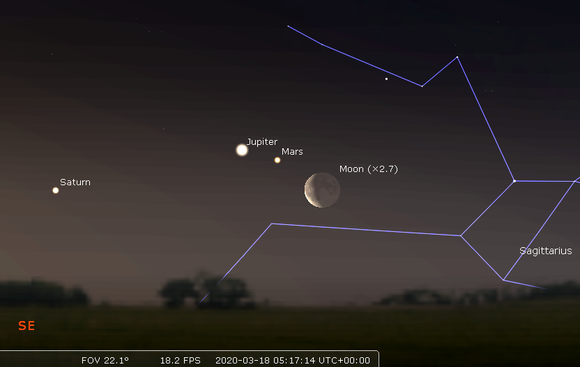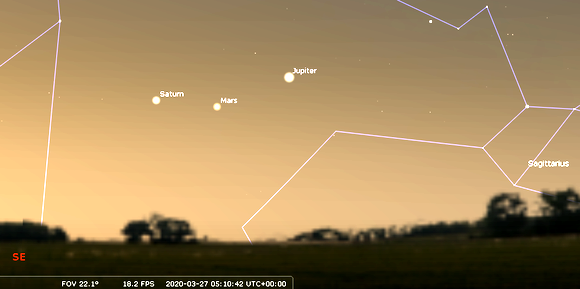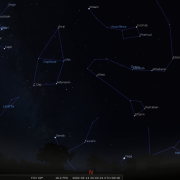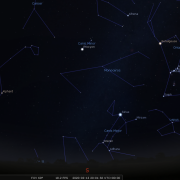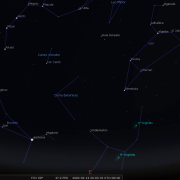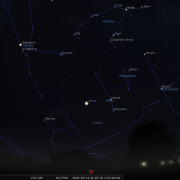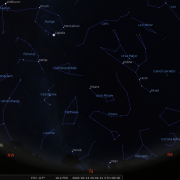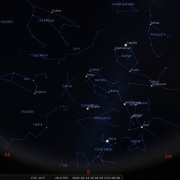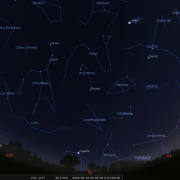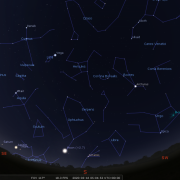
Note the two Society Meetings in March (see below).
Welcome to the WDAS monthly newsletter for March 2020: a digest of the month's latest contributions to our website. Below you'll find Society News: including write-ups of the Dark Skies events at Danby Moors Centre and the Fox & Hounds; forthcoming events; and naturally your Sky Notes for March.
Society News
Subscription renewals for the coming year are due by the end of February. Subscription rates are £12, for adults with subsidized rates at £8 for under 16s.
You can bring subs along to the W.D.A.S monthly meeting in February, or if you cannot make the meetings Cheques are made payable to;- Whitby & District Astronomical Society, Please address to Mark Dawson - 33 laburnum Grove, Whitby. YO211HZ. Many thanks for your continued support.
As of going to press just a few copies of Night Scenes 2020 remain. Price is £5.
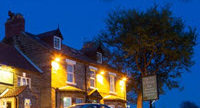
Our first event of the Dark sky festival weekend (first weekend that is) saw us return to the Fox and Hounds at Ainthorpe. Our first visit last October had proved rather frustrating with low cloud and then persistent heavy rain, preventing any chance of observing, or indeed any outdoor demonstration occurring. Indoor presentations were the order of the evening, which turned into an enjoyable affair.

Hopes were therefore high for something along similar lines, but this time with observations of the winter sky from the hotel beer garden. Our hopes were dashed. The rain mostly held off (until much later in the evening) the wind however was horrendous, no telescope would have held steady. Intermittent cloud cover also didn’t help matters. Mark and Keith had made the journey up, Mark having already transported several telescopes, poster boards and demo items up to the venue the previous afternoon. Hosts Colin and Vicky (with new baby arrival) welcomed us on arrival and after setting up in the games room/come ‘lecture theatre’, Colin gave an introductory speech to the assembled guests (14 I believe) who were staying for the weekend’s events. Mark then gave a presentation utilising Starry Night 8, showing what should have been visible in the late February night sky.
Every so often Colin slipped out to see if any decent cloud breaks would allow at least some naked eye observations to be made. With less than 30 minutes before the scheduled dinner break, a thumbs up came and donning winter garb, we ventured outside and up to the stable yard buildings, where at least some protection from the exceedingly blustery wind could be found. Using the laser pointer, Mark pointed out as best he could any winter constellations or stars which fleetingly appeared in a wreck of a sky. It transpired 30 minutes was about as much as anyone could take in the wind. Dinner called. This was every bit as tasty as last time, and as conversations ranged across a wealth of subjects, continents and decades, it became apparent from the wind rattling and rain streaked windows, our evening was about done.
Only essential equipment was re loaded into the car, the rest (including scopes etc) was safely stored for the following evening’s event down the road at Danby. Farewells were said (brief ones only as all the guests were booked into the Danby event) and the journey home made.
So, what would Saturday evening throw up? Well, Mark first returned back to the Fox and Hounds in the late morning to reload the stored equipment and relocate to the Moors Centre. This took quite a while, but at least it meant equipment was ‘on site’ for the evening. Looking at the forecast for the evening prospects looked quite encouraging... and rather pessimistic at the same time! Evening fell, Keith, Mark, Barbara and Mark journeyed up under ‘pessimistically encouraging’ skies, joining Paul Wood, who had been there quite a while already. Paul Cass and Dr John McCue also brought their scopes along.

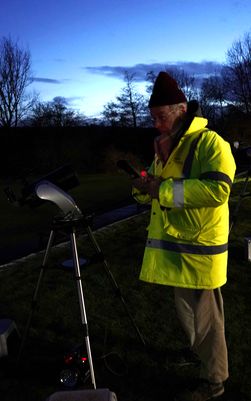
Portage of telescopes from upstairs and erecting on the front upper terrace then became our main priority. Straight away teething problems arose with three of the scopes. The Tal refractor head and tripod stand refused to marry up, so a shotgun wedding ensued and although not sited properly the two stayed intact for the remainder of the evening. Mark thought the collimation on the smaller 6 inch dobsonian was off, but was ok for the evening. The small meade ETX had to be taken out of line, as nothing could be see through it! This was later found to be the diagonal mirror, which had come unstuck from its base and was rattling around in the tube. A project for the weekend!
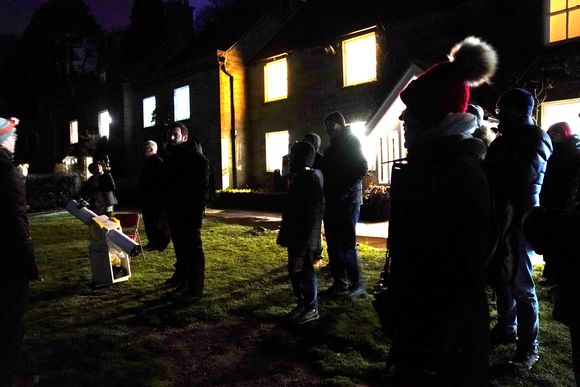
Fortunately there were enough instruments set up and functioning properly, and miraculously conditions were pretty decent, the wind had subsided considerably, skies were clear enough and it wasn’t perishing. Over 70 people had booked for the event (including the Fox and Hounds contingent) and with lady luck favouring us, it was pleasing (to say the least) to observe some of the wonders of the winter night sky in relative comfort. Mark gave a laser point tour, whilst people queued at the eyepiece to view the Orion nebula, Pleiades, M35 open cluster, the beehive, Mizar and alcor, Castor, Betelgeuse, M41 and a number of other deep sky objects. The time slipped by quite quickly.
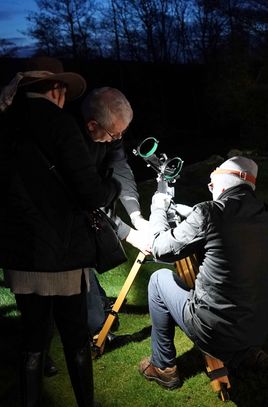
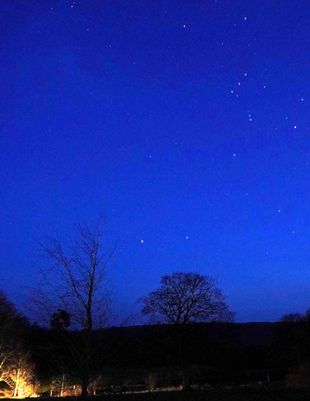
As agreed with Karen, following a tea and biscuit break, Mark gave a couple of quick presentations in the lecture room. One on the celestial highlights to look out for this year, and another on some of the deep sky wonders to look for with a smaller scope. Whilst the IT was getting sorted in preparation for this, the instruments outside were brought indoors – or packed away, just in time apparently as a small rain shower appeared from nowhere.
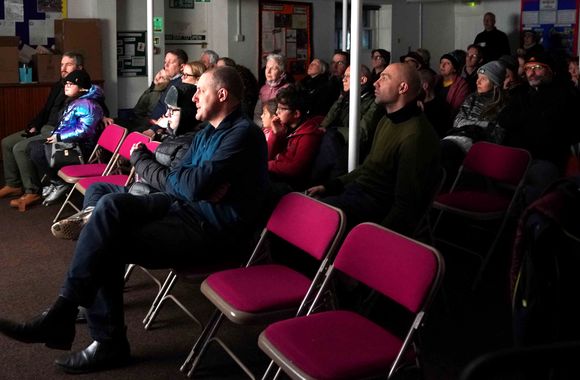
By 20:35h it was time to call a halt (Mark only overrunning by 5 mins) I think the evening had been a great success, much appreciated by all those attending who perhaps don’t often get the opportunity to view deep sky objects from dark sky locations. Karen was delighted with the positive feedback. By 21:00h everything was packed away into the cars, and after final goodbyes we headed back home.
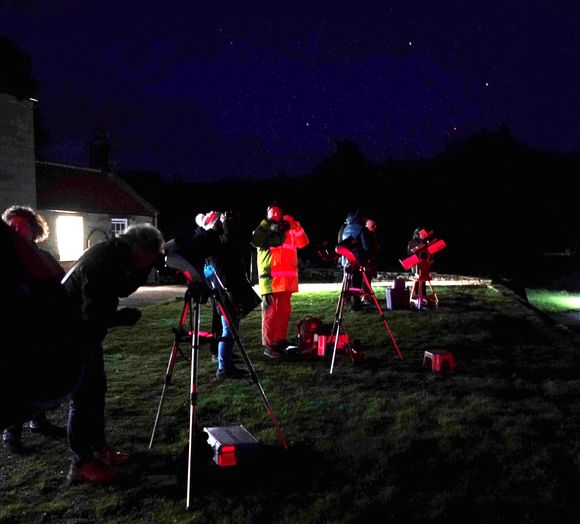
Many thanks to Keith, Barbara and Mark, Paul C, John and Paul W, Karen and all the staff at the Moor’s Centre, for making the evening work. Considerably hard work goes into these events – and for once the weather came on board too!

We have been contacted by Allan Fishpool, lower key stage 2 Leader at Errington Primary School, Windy Hill Lane, Marske by the Sea, who would like us to assist with an event they are holding on March 13th (Friday).
The School is running a science week that week, culminating in the Year 3/4s being invited for a sleepover in the school on the Friday night, the theme for the week being space and astronomy. They would like a star gazing evening, maybe with a campfire and stories of constellations myths, as well as indoor practical activities.
Sounds like an interesting evening and we would be happy to help out. The arrival time for us is 19:00h, further details will be forthcoming at the March meeting. If anyone can come along to help out who cannot make our March meeting, please drop Mark an email for details.
Our association with Ayresome Primary School & Lego Innovation Studio will be continued again this year after been contacted by Elizabeth Labelle; assistant Head Teacher (phase 3).

This year’s group of pupils (around 30 or so) will be stopping at the Whitby Youth Hostel from April 6th-10th and we will be hosting a star party event for them on either the 8th or 9th, whichever evening according to the forecast looks best.
We have hosted these events for the last four years and they are much appreciated by the pupils, who according to Libby, seem to benefit from their time under the stars. Start time will be around 20:15h on the Abbey visitor centre grass forecourt area.
Because Caedmon College’s Easter break runs from April 6th to the 17th, means that our normal Tuesday April meeting date on the 7th falls within this period, and the next Tuesday date will not be until the 21st, which is actually nearer the final meeting date in May.
We have therefore made the decision to have our ‘April’ meeting on the last day of March – Tuesday the 31st March 2020. (Well spotted Elaine!) This will be at the normal time. Think it makes better sense.
Last call for anyone renewing sub’s (most have been) Subscription rates have been kept the same i.e £12, for adults with subsidized rates at £8 for under 16’s.
You can bring subs money/cheques along to the WDAS monthly meetings in December, January or February. If you cannot make the meetings, cheques are made payable to: Whitby & District Astronomical Society. Please address to:
Mark Dawson
33 Laburnum Grove
Whitby. YO21 1HZ.
Sky Notes
In this month's Sky Notes:
Planetary Skylights
Evening Planets
Venus rules in the evening sky, whilst Mars, Jupiter and Saturn vie for attention in the dawn sky.
 Venus is totally dominant in the evening sky, not setting until almost midnight by the end of March (after BST commences) If you want to view Venus satisfactorily through the ‘eyepiece’, try to observe in bright twilight and not when fully dark, by which time it is rather too dazzling.
Venus is totally dominant in the evening sky, not setting until almost midnight by the end of March (after BST commences) If you want to view Venus satisfactorily through the ‘eyepiece’, try to observe in bright twilight and not when fully dark, by which time it is rather too dazzling.
You will at least discern the phase (a half phase) and perhaps some subtle darker markings in the clouds. The surface is perpetually hidden under the thick cloud duvet that traps nearly all the heat in, making the surface of Venus the hottest of any planet.
As Venus continues to move up through Pisces and into Aries, it passes Uranus on the 7th approximately 2 degrees to the left of Venus. You will require binoculars to spot fainter Uranus and a telescope to reveal the tiny disk.
 The crescent Moon joins Venus on the 28th which has moved up below the lovely Pleiades star cluster making for a pretty picture indeed. Next month Venus ploughs right through the Seven Sisters.
The crescent Moon joins Venus on the 28th which has moved up below the lovely Pleiades star cluster making for a pretty picture indeed. Next month Venus ploughs right through the Seven Sisters.
 Uranus resides in Aries, which is slipping down towards the West horizon, passing Venus on the way up on the 7th and 8th. Although technically visible to the naked eye at mag +5.9, in reality binoculars, or better still, a telescope are required to spot it. Uranus resides just within the borders of Aries approximately 4 degrees below the ‘crooked line’ asterism of the Ram. If you have a constellation chart or App etc, use Mesarthim and iota Aries as pointers to locate Uranus, which resides roughly 3 times the distance between these stars and a tad to the right, below them. Through a telescope Uranus resembles a very small disk of subtle grey/green hue.
Uranus resides in Aries, which is slipping down towards the West horizon, passing Venus on the way up on the 7th and 8th. Although technically visible to the naked eye at mag +5.9, in reality binoculars, or better still, a telescope are required to spot it. Uranus resides just within the borders of Aries approximately 4 degrees below the ‘crooked line’ asterism of the Ram. If you have a constellation chart or App etc, use Mesarthim and iota Aries as pointers to locate Uranus, which resides roughly 3 times the distance between these stars and a tad to the right, below them. Through a telescope Uranus resembles a very small disk of subtle grey/green hue.
Dawn Planets
Much of the planetary action occurs in the dawn sky, where Mars, Jupiter and Saturn all reside. A clear uncluttered horizon will make things easier for identification. As March progresses look for ‘ruddy’ Mars rapidly closing in on much more conspicuous Jupiter.
 Mars is currently only as bright as an average first magnitude star (Mag +1.25). Mars and Jupiter are closest on the 20th, separated by just over half a degree. View around 05:00-5:30h.
Mars is currently only as bright as an average first magnitude star (Mag +1.25). Mars and Jupiter are closest on the 20th, separated by just over half a degree. View around 05:00-5:30h.
18-Mar-2020 at 05:15h (SE): Dawn planets Jupiter, Mars and Saturn with a Crescent Moon.
(Click for full-sized image)
 The red planet then closes in on Saturn passing below the ringed planet on the last day of the month. Saturn is also brighter than Mars, which in the eyepiece appears disappointingly small to yield meaningful views, unless you have serious ‘instrumentation’.
The red planet then closes in on Saturn passing below the ringed planet on the last day of the month. Saturn is also brighter than Mars, which in the eyepiece appears disappointingly small to yield meaningful views, unless you have serious ‘instrumentation’.
 Jupiter and Saturn do however have something to offer, whether it’s the rings of Saturn, or the cloud belts and major moons of Jupiter. Just be aware that the low altitude will effect observations, what astronomers refer to as ‘seeing’ will be challenging for the time being.
Jupiter and Saturn do however have something to offer, whether it’s the rings of Saturn, or the cloud belts and major moons of Jupiter. Just be aware that the low altitude will effect observations, what astronomers refer to as ‘seeing’ will be challenging for the time being.
The waning Moon passes just beneath the dawn planets on the 18th and 19th.
Meteors

No major showers this month; however at the very end of March you may spot a few Virginids, which are slow moving and have long paths. As usual early morning hours are best to spot any meteors.
Spring Equinox
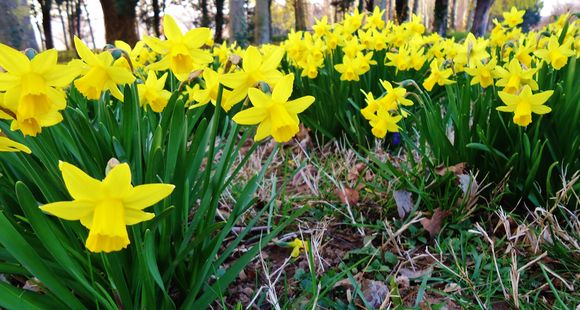
The date of the Vernal Equinox and for the northern hemisphere, the start of astronomical spring, falls on March 20th this year. On this date the Sun's path on the ecliptic crosses the celestial equator on its apparent journey northwards into the sky. The orientation of the Earth at the spring or autumnal equinox is such that neither of Earth’s poles is inclined toward the Sun and all locations experience equal hours of daylight and darkness - hence the term equinox.
The Vernal Equinox is also known as the 'First point of Aries', as the Sun used to stand before the constellation of the Ram when it first crossed the celestial equator. Although still called the 'first point of Aries', today its location now resides in Pisces, a consequence of the effect known as precession; the Earth's slow wobble
Over thousands of years our ancestors noted that certain star patterns rose just before the Sun at specific times and were considered significant for this very reason. Subsequently they were able to build a picture of the apparent path of the Sun against these constellations.
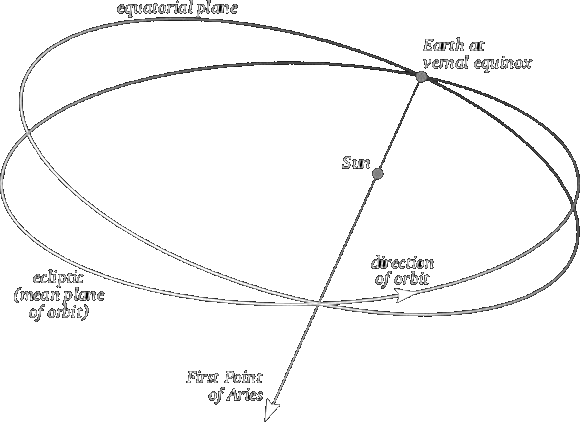
The narrow path upon which occasionally the Sun and Moon would meet giving rise to an eclipse, became known as the Ecliptic. The broader belt along which the 'wandering stars' or planets travelled was known as the Zodiac, so called because all 12 constellations located on it were associated with living creatures.

Zodiac literally means 'Band of Animals'. Libra used to be considered being part of Scopius, the claws to be precise. Ophiuchus, the serpent bearer immediately following Scorpius was instead regarded as a zodiac group. Ever since the stars of Libra were elevated in status, Ophiuchus, being surplus to requirements, was ditched, much to the relief of astrologers. If you find it difficult to remember the order of the zodiac constellations, then the following rhyme may be of use.
The Ram, the Bull, the Heavenly twins
and next the Crab the Lion shines,
The Virgin, and the Scales.
Scorpion, Archer and Sea goat,
The man who pours the water out
and Fish with glittering tails
|
Looking North
Mid-March - 20:00h |
Looking South |
|
Looking East
Mid-March - 20:00h |
Looking West
Mid-March - 20:00h |
|
Northern Aspect
Mid-March - 20:00h |
Southern Aspect
Mid-March - 20:00h |
|
Looking North (Early)
Mid-March - 05:00h |
Looking South (Early)
Mid-March - 05:00h |
Additional Image Credits:
- Planets and Comets where not otherwise mentioned: NASA
- Sky Charts: Stellarium Software
- Spring Equinox images: Wikipedia Commons
Events
 Observe the night sky with us at the Bruce Observatory, Whitby School
Observe the night sky with us at the Bruce Observatory, Whitby School
Observing Nights are held weather permitting: check for a relatively clear sky before leaving home. If in doubt, Mark can be reached on 07886069339
Please note the college drive gate is now operated via a electronic key code - so anyone wishing to attend must be at the car park at the top of the drive by 19:00hrs - unless an arrival time has been arranged with Mark/Keith.
 Observe the night sky with us at the Bruce Observatory, Whitby School
Observe the night sky with us at the Bruce Observatory, Whitby School
Observing Nights are held weather permitting: check for a relatively clear sky before leaving home. If in doubt, Mark can be reached on 07886069339
Please note the college drive gate is now operated via a electronic key code - so anyone wishing to attend must be at the car park at the top of the drive by 19:00hrs - unless an arrival time has been arranged with Mark/Keith.
 Observe the night sky with us at the Bruce Observatory, Whitby School
Observe the night sky with us at the Bruce Observatory, Whitby School
Observing Nights are held weather permitting: check for a relatively clear sky before leaving home. If in doubt, Mark can be reached on 07886069339
Please note the college drive gate is now operated via a electronic key code - so anyone wishing to attend must be at the car park at the top of the drive by 19:00hrs - unless an arrival time has been arranged with Mark/Keith.
 Whitby School - Room H1.
Whitby School - Room H1.
In Members' monthly meetings we usually take a tour of the night sky for the coming month using the Planetarium program. Have talks and presentations on various topics of astronomy/space etc, and discuss future events etc. New members welcome.

